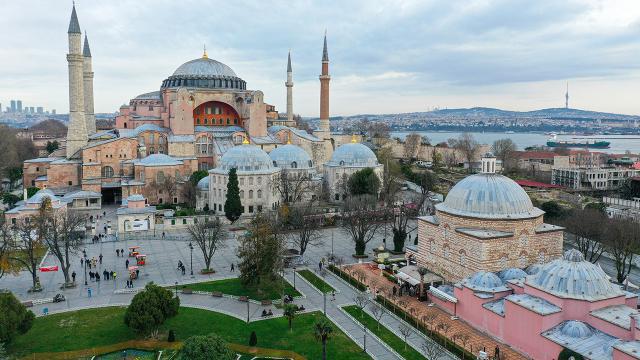Hagia Sophia, officially the Hagia Sophia-i Kebir Mosque, formerly the Hagia Sophia Church or Hagia Sophia Museum (Greek: ἉΓία Σοφία Hagia Sophia), is a mosque, former basilica, cathedral and museum located in Istanbul. Byzantine Emperor I. The basilica, built by Justinian between 532 and 537 in the old city center on the historical peninsula of Istanbul, is a planned patriarchal cathedral and was built in 1453 after the conquest of Istanbul by the Ottomans II Dec It was converted into a mosque by Mehmed. It was deconstructed into a museum by the Decree of the Council of Ministers issued by Mustafa Kemal Ataturk in 1934, excavations and renovations were started, and it served as a museum for people of all faith groups between 1935 and 2020. in 2020, the museum status was canceled and the mosque status was granted.
Hagia Sophia is a domed basilica-type structure that combines the central plan in architectural terms and is considered an important landmark in architectural history with its dome transition and load-bearing system features. Besides its symbolic and october meaning for Christians, it is a tourist and spiritual attraction center.
The word "Aya" in the name of Hagia Sophia means "holy, saint". The word "Sofia" comes from the Ancient Greek word sophos, which means "wisdom".Therefore, the name "hagia sophia" means "Holy Wisdom" or "divine wisdom" and is considered one of the three attributes of God in the sect of Orthodoxy. Isidoros of Miletus and Antemius of Tralles directed the construction of Hagia Sophia, which employed about 10,000 workers and I. It is noted that Justinian spent a huge fortune on this work.A feature of this very old building is that some of the columns, doors and stones used in its construction were brought from structures and temples older than the building.
During the Byzantine Empire, Hagia Sophia had a great wealth of "holy relics". One of these relics was a 15-meter-high silver iconostasis. The patriarchal church of the Kostantiniyye Patriarchate and Hagia Sophia, which has been the center of the Orthodox Church for millennia, was founded in 1054 by Patriarch I. He was the son of Michael Kirularios, Pope John IX. He witnessed the excommunication by Leo, and this event is generally considered the beginning of the Schism, that is, the separation of the Eastern and Western churches.
After the church was turned into a mosque in 1453, those of its mosaics that contained human figures were not destroyed (those that did not were left as they were), but only covered with a thin plaster and remained under plaster for centuries, so that it could survive natural and artificial destruction. While the mosque was being converted into a museum, some of the plasters were removed and the mosaics were brought to light again. The Hagia Sophia building seen today is also known as the "Third Hagia Sophia" because it is actually the third church built on the same place. The first two churches were destroyed during the riots. The central dome of Hagia Sophia, the widest dome of its era, collapsed once during the Byzantine period (May 7, 558), and it has never collapsed since Architect Sinan added the buttresses to the building.

